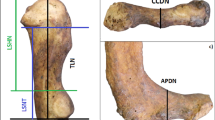Abstract
One of the first steps in the identification of human remains is sex estimation. Discriminant functions are very useful for this purpose, as they are based on the fundamental premise of the sexual dimorphism in osseous remains. However, the absence of studies of this kind in the thoracic cage is visible, and adequate cause to justify this work. To this purpose, we analysed and measured a set of ribs, R1 to R4, belonging to skeletons of contemporary chronology (1970–2010), in order to obtain discriminant functions enabling sex estimation through equations applied to the rib neck. The sample comes from the Cemetery of San José, which is located at the Laboratory of Anthropology at the University of Granada. All data from this sample was known: ancestry, sex, age-at-death and cause of death. Results showed a percentage of success of approximately 80–88% in ribs R2 to R4, and approximately 85–90% in R1, reaching up to 93.2%. Results from intra-/inter-observer error tests show excellent reproducibility of the method. The data confirms that it is possible to estimate sex from the rib neck.

Similar content being viewed by others
Change history
19 March 2021
A Correction to this paper has been published: https://doi.org/10.1007/s00414-021-02567-2
References
Meindl RS, Lovejoy CO, Mensforth RP, Carlos LD (1985) Accuracy and direction of error in the sexing of the skeleton: implications for paleodemography. Am J Phys Anthropol 68:79–85. https://doi.org/10.1002/ajpa.1330680108
Alemán I, Botella M, M.C, Ruiz L (1997) Determinación del sexo en el esqueleto poscraneal. Estudio de una población mediterránea actual. Arch Esp Morfol (2):69–79
Spradley K, Jantz R (2011) Sex estimation in forensic anthropology: skull versus postcranial elements. J Forensic Sci 56(2):289–296. https://doi.org/10.1111/j.1556-4029.2010.01635.x
Klales A (2020) Sex estimation of the human skeleton. History, methods and emerging techniques. Academic Press, Kansas. https://doi.org/10.1016/C2017-0-03550-4
Krenzer U (2006) Compendio de métodos antropológico-forenses para la reconstrucción del perfil osteobiológico. Centro de Análisis Forense y Ciencias Aplicadas, Guatemala
Genovés S (1962) Introducción al diagnóstico de la edad y el sexo en restos óseos prehistóricos. Universidad Nacional Autónoma de México, México
Carretero J, Lorenzo C, Arsuaga J (1995) Análisis multivariante del húmero en la colección de restos identificados de la colección de Coimbra (Portugal). Antropol Port (13):139–156
Iscan, M., Miller-Shaivitz, P. (1986) Sexual dimorphism in the femur and tibia. In: Reichs, K. (ed) Forensic osteology: advances in the identification of human remains. Springfield, Charles C. Thomas, Springfield, pp. 101-111.
García Parra P, Pérez Fernández A, Djorojevic M, Botella MC, Alemán I (2014) Sexual dimorphism of human sternum in a contemporary Spanish population. Forensic Sci Int (244):313.e1–313.e9. https://doi.org/10.1016/j.forsciint.2014.06.019
Krishan K, Chatterjee P, Kanchan T, Kaur S, Baryah N, Singh R (2016) A review of sex estimation techniques during examination of skeletal remains in forensic anthropology casework. Forensic Sci Int 261:165.e1–165.e8. https://doi.org/10.1016/j.forsciint.2016.02.007
Dabbs GR (2009) Is Dwight right? Can maximum height of the scapula be used for accurate sex estimation?*. J Forensic Sci 54:529–530. https://doi.org/10.1111/j.1556-4029.2009.01039.x
Bellemare F, Fuamba T, Bourgeault A (2006) Sexual dimorphism of human ribs. Respir Physiol Neurobiol 150:233–239. https://doi.org/10.1016/j.resp.2005.04.002
Bellemare F, Jeanneret A, Couture J (2003) Sex differences in thoracic dimensions and configuration. Am J Respir Crit Care Med 168:305–312. https://doi.org/10.1164/rccm.200208-876OC
Bellemare J, Cordeau M, Leblanc P, Bellemare F (2001) Thoracic dimensions at maximum lung inflation in normal subjects and in patients with obstructive and restrictive lung diseases. Chest 119:376–386. https://doi.org/10.1378/chest.119.2.376
Lynch J, Cross P, Heaton V (2017) Sexual dimorphism of the first rib: a comparative approach using metric and geometric morphometric analyses. J Forensic Sci 62:1251–1258. https://doi.org/10.1111/1556-4029.13421
White T, Black W, Folkens P (2011) Human osteology, 3ª edn. Academic Press, California
White T, Folkens P (2005) The human bone manual. Academic Press, Berkeley
Ramey Burns K (2008) Manual de Antropología, Forense. edn. Bellaterra, Barcelona
Lin L (1989) A concordance correlation coefficient to evaluate reproducibility. Biometrics 45:255–268
McBride G (2005) A proposal for strength-of-agreement criteria for Lin’s concordance correlation coefficient. National Institute of Water and Atmospheric Research. Ltd. Hamilton, New Zealand
Ferrante L, Cameriere R (2009) Statistical methods to assess the reliability of measurements in the procedures for forensic age estimation. Int J Legal Med 123:277–283. https://doi.org/10.1007/s00414-009-0349-4
Scheuer J, Elkington N (1993) Sex determination from metacarpals and the first proximal phalanx. J Forensic Sci 38:769–778
Crapo R, Morris A, Clayton P, Nixon C (1982) Lung volumes in healthy nonsmoking adults. Bull Eur Physiopathol Respir 18(3):419–425
Acknowledgements
The authors would like to acknowledge Emucesa, the San José Cemetery Company of Granada, for allowing us access to study material, also to the Laboratory of Physical Anthropology of the University of Granada and the anonymous reviewers for their valuable comments.
Funding
This work has been supported by a grant from the FPU Research and Teaching Fellowships (Becas de Formación de Profesorado Universitario FPU), 2018 announcement, ref. FPU18/00669, from the Ministry of Education and Professional Formation, Government of Spain.
Author information
Authors and Affiliations
Corresponding author
Ethics declarations
Ethics Approval
Not applicable.
Informed consent
Not applicable.
Conflict of interest
The authors declare no competing interests.
Additional information
Publisher’s note
Springer Nature remains neutral with regard to jurisdictional claims in published maps and institutional affiliations.
The original online version of this article was revised: The original article contains an error in Figure 1. In the published article, two of the measurements were incorrect. “LT” should be replace with “LH” and “LSHN should be LSNT” and vice versa.
Rights and permissions
About this article
Cite this article
Partido Navadijo, M., Fombuena Zapata, I., Borja Miranda, E.A. et al. Discriminant functions for sex estimation using the rib necks in a Spanish population. Int J Legal Med 135, 1055–1065 (2021). https://doi.org/10.1007/s00414-021-02537-8
Received:
Accepted:
Published:
Issue Date:
DOI: https://doi.org/10.1007/s00414-021-02537-8




